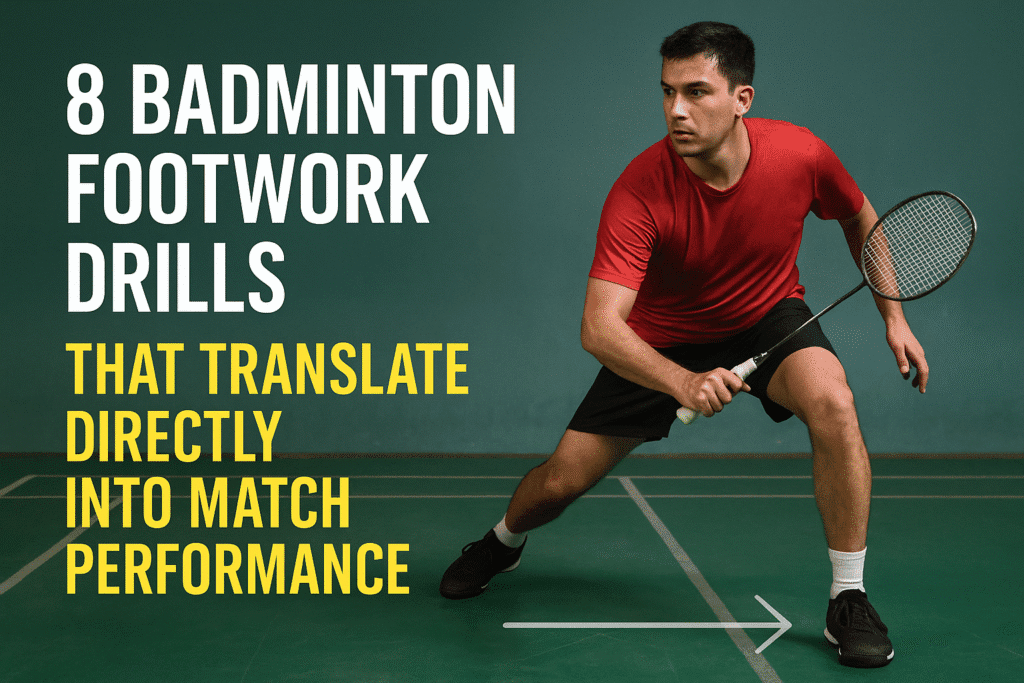Badminton Footwork Drills That Translate Directly into Match Performance


Introduction
Effective footwork separates good players from great ones. These drills aren’t just for practice court—they’re designed to replicate match situations and improve your ability to move, recover, and strike with precision under pressure.
Table of Contents
- Why Match-Ready Footwork Matters
- The 8 Game-Translating Drills
- Common Mistakes & How to Avoid Them
- Pro Tips for Better Footwork
- How to Structure Your Footwork Training
- FAQ
1. Why Match-Ready Footwork Matters
- It ensures you react faster and reach challenging shots effectively.
- Improved posture and positioning give you cleaner shot setup, better balance, and energy conservation.
- Footwork missteps can lead to energy drain and even injury.
2. The 8 Game-Translating Drills
1. High-Knee Running
Boost explosive leg power to cover the court faster and with control.
2. Pattering on the Spot
Sharpen directional precision to move fluidly without losing balance.
3. Short Front Split (Forward Lunges)
Mimic reach for net drops and returns—with quick recovery built-in.
4. Short Side Split (Lateral Lunges)
Simulate cross-court thrusts and defensive responses.
5. Single-Leg Zig-Zag Hops
Bolster stability and agility—ideal for landing from deep lunges or split steps.
6. Sideways Chassé
Perfect lateral shuffle with ease—a vital move during fast rallies.
7. One-Step Shadows
Shadow-play replicates dynamic match movement—this builds muscle memory for real gameplay.
8. Squat and Split
Blend endurance, strength, and flexibility for aggressive play and quick recovery.
3. Common Mistakes & How to Avoid Them
- Flat-footed movement slows response time—stay on the balls of your feet.
- Using large, bounding steps makes movement sluggish; use small, controlled steps instead.
- Crossing feet during lateral shuffles causes imbalance.
- Recovery to “ready position” is often neglected—don’t end drills static.
4. Pro Tips for Better Footwork
- Warm up dynamically: light jogging and dynamic stretches before starting.
- Technique first: perfect form at low speed before increasing intensity.
- Progress gradually: speed up the drills as you improve.
- Cool down well: stretch to maintain flexibility and aid recovery.
- Use proper gear: quality badminton shoes help grip, stability, and joint protection.
5. How to Structure Your Footwork Training
| Drill Phase | Duration/Intensity | Focus |
|---|---|---|
| Warm-up | 5–10 minutes | Dynamic stretches & easy footwork |
| Technical Practice | 3 sets × 30–60 sec per drill, controlled | Form, posture, precision |
| Speed Phase | 3 sets × 30–45 sec, rapid pace | Agility, reaction speed |
| Recovery Work | Light footwork + stretches | Balance, stamina, injury prevention |
- Practice shadow footwork within rallies for transition smoothness.
- Include footwork drills early in sessions when energy is highest.
- Mix short sprint sets or shuttle bursts to mimic match intensity.
6. FAQ
Q: How often should footwork drills be practiced?
At least 2–3 times per week for muscle memory and agility gains.
Q: Can these drills be done solo?
Absolutely. Many drills—shadows, splits, zig-zag hops—are solo-friendly and effective.
Q: Can beginners use these drills?
Certainly—just start slowly and prioritize correct technique before ramping up speed.